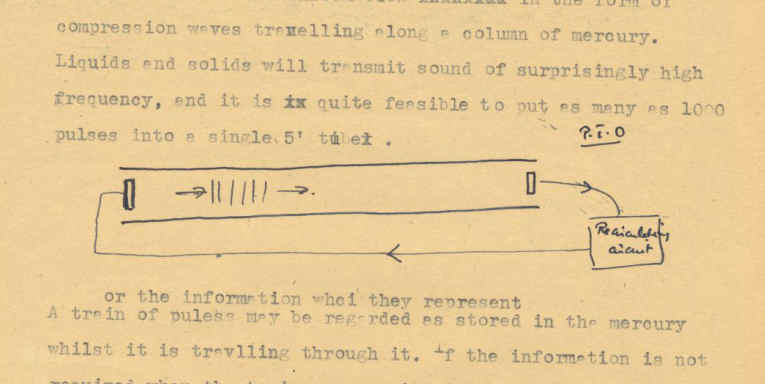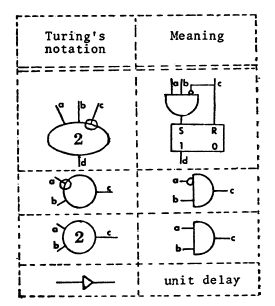| Alan Turing's ACE |
| Written by Historian | ||||||
Page 2 of 2
Delay Line StorageThe Pilot ACE was a very strange machine by today's standards mainly because it was heavily influenced by the type of hardware available and the need to be fast and efficient. The memory was based on acoustic delay lines. Bit streams were stored by converting them into sound pulses which circulated in a mercury delay line. The modern equivalent of such a memory device would be a shift register clocked to keep a bit pattern circulating.
Turing's sketch of a delay line Other computers of the time used delay line storage but Turing had decided to try to make the best possible use of crude technology. The main store of the machine used ten delay lines each holding 32 words of 32 bits. There were also six temporary stores implemented as short delay lines each capable of holding a 32-bit number. The operations of the Pilot ACE allowed the programmer to specify move operations from one delay line to another. This was achieved by waiting for the number to come round and then "gating" it into the data flow of another delay line. Because it was arranged so that the numbers emerged from the delay lines at the same moment you could only move the nth number in a delay line to become the nth number in another delay line. If you wanted to change the order of numbers in the long delay lines you had to first transfer the number to a short delay line and then wait for the position in the destination to come round. This made programming more like juggling. If you also look at Turing's sketches for the logic of the machine you will be surprised to discover that it doesn't look like a modern arrangement of And, Or and Not. In fact the gates used look more like artificial neurons of the McCullock-Pitts type. In other words, the logic looks altogether more biologically inspired than the Boolean logic we tend to use today.
Turing's Rotator (Carpenter & Doran, The other Turing machine, 1977)
Turing's Logic Gates in Modern Form What made the Pilot ACE so strange is that the arithmetic and logical operations were built into the delay line storage. The contents of one delay line could be transferred to another, so overwriting what was already stored there, or they could be added, ANDed and so on. The logic of the machine was built into the storage arrangements and this is what made it so fast. You also have to remember that the ACE program was also stored in the delay lines. To make this more efficient each instruction included the address of the next instruction as a position in the delay line. This allowed the program to be stored in any order, not just the "one-after-the -other" storage layout we use in a Von Neumann computer. A perfect ACE program would have the instruction order arranged so that the next instruction to be executed was emerging from the delay lines just as it was required. You can see that programming the Pilot ACE wasn't an abstract operation. You had to think about the numbers and commands circulating in the delay lines. In addition the instructions actually contained references to the delay line timings and multiple operations could be performed in this way. The description of the Pilot ACE may make you think that this machine was too difficult to use but far from it. The strange architecture resulted in a machine that was very fast for the time. It was clear very early on that the Pilot ACE wasn't just a test machine but was capable of being used for real-world tasks. It was modified a little and by early 1952 the machine was in regular use by the NPL Mathematics Division. Wilkinson began to write programs that laid the foundation of the subject of modern numerical methods. In the years 1952 to 1955 the Pilot ACE was the fastest computer available and the NPL became a world centre for numerical mathematics. Because so many programs were available for the Pilot ACE, and because the NPL provided computing to government and industry, English Electric decided to build a commercial version of the Pilot ACE. They added a magnetic drum, which fitted in with the circulating store principle of the delay line, and increased the power of the machine. The commercial Pilot ACE was called the DEUCE and one of the first was installed at NPL in 1955. The Full ACEThe Pilot ACE was a successful, if somewhat strange computer, but the NPL decided to push on and build the full machine - the ACE. This had a 48-bit word size but still used delay lines for storage. It contained 7000 valves and could multiply two numbers in .5ms. The ACE was completed in 1957 and it certainly looked impressive. A huge array of electronics cabinets arranged in a semi-circle makes it look like a large Cray supercomputer to the contemporary eye. To complete the space age look each cabinet had a huge sliding panel which could be lifted under the control of an electric motor.
ACE The sad fact is that while the ACE may have looked every bit the modern advanced computer it was an anachronism before building commenced. Other computers of the time used true random access storage and the Von Neumann architecture had become the norm. When you add to this the fact that computers started to use transistors during the building of the ACE you can see that it had none of the impact that the Pilot ACE had. People in the NPL recognized that the ACE was obsolete and wanted to abandon the project but it was swept along on the success of the Pilot ACE. Was building a machine as odd as the Pilot ACE a mistake? One of the surprising things is that Turing's design was far from the abstract logic he is usually associated with. If you compare his initial paper on the ACE with Von Neumann’s description of the EDVAC the difference is striking. Von Neumann described an abstract computer that was more or less independent of the practicalities of building it, but Turing concentrated almost exclusively on the practicalities. As a result the Pilot ACE was powerful to an extent that even surprised its designers. The 800-valve Pilot ACE was several times faster than the 3000-valve EDSAC. This allowed its users to develop programs and theories of real significance in numerical analysis and engineering. Eventually 32 of the commercial versions, the DEUCE, were sold, more because companies demanded them than because of aggressive marketing. In the States another derivative of the ACE, the Bendix G-15, sold more than 400 units and this gives you some idea of the potential of the machine if marketed correctly. Even so the ACE/DEUCE combination did more for computing in UK industry than any other machine. In a sense the ACE was the UK's "national" computer.
More InformationThe Other Turing Machine, The Computer Journal Vol 20 (3), 1977
Related ArticlesManchester Computers of the 1950s GCHQ Puzzle For Alan Turing £50 Note Alan Turing and his contemporaries (book review) Alan Turing's Electronic Brain (book review) Commemorative Stamp for Alan Turing Turing Centennial Celebration at Princeton
To be informed about new articles on I Programmer, sign up for our weekly newsletter, subscribe to the RSS feed and follow us on Twitter, Facebook or Linkedin.
<ASIN:1862078394> <ASIN:1840462507> <ASIN:1906124906> <ASIN:1107020581> |
||||||
| Last Updated ( Saturday, 07 June 2025 ) |




